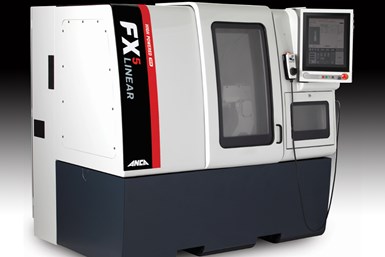Anca Upgrades FX5 Linear Grinding Spindle Power
Anca has upgraded its FX5 Linear’s grinding spindle from 9.5 kW to 12 kW, also offering a 19-kW upgrade. This power increase boosts productivity and flexibility.
Share





.png;maxWidth=45)
DMG MORI - Cincinnati
Featured Content
View More
Takumi USA
Featured Content
View More
Hwacheon Machinery America, Inc.
Featured Content
View More


Anca has upgraded its FX5 Linear two-wheel pack machine from a 9.5-kW grinding spindle to a spindle rated at 12 kW peak power, also offering a high-powered, 19-kW spindle option.
To keep cost per produced tool at a minimum, Anca says CNC tool grinders strive to achieve the shortest possible cycle times — and machine performance and grinding cycle time are linked to the power capabilities of the grinding spindle.
The company also says a commonly accepted industry practice to maximize removal rate is limiting the spindle load to between 30% and 40% for fluting operations. If the spindle load is likely to exceed 40%, tool manufacturers tend to allow for a second fluting pass, as this contributes to longer wheel life and lower wheel load.
The FX5’s 12 kW spindle can grind tools up to 10 mm in diameter in a single pass, but increasing the tool size to 12 mm requires a second grinding pass to keep the spindle load at 40%. The 19-kW spindle, however, grinds 12-mm tools at 40% — Anca’s tests showed the single-pass approach with this spindle saved one minute and four seconds compared to two passes at 12 kW.
Overall, Anca says the use of “One Pass Productivity” for tools with a 12-mm diameter translates into an increased output of 15.8%, producing 70 tools in an eight-hour shift compared to 60 tools with the new standard 12-kW spindle.
Anca acknowledges that complex cutting tools have further factors influencing grind cycles besides the tool geometry. These include the quality of the grinding wheel and an adequate supply of cooling liquid, the latter of which prevents thermal damage to the workpiece. As batch sizes increase, auto white-sticking also helps to achieve maximum output by frequently refreshing the wheel.
Related Content
-
Ballbar Testing Benefits Low-Volume Manufacturing
Thanks to ballbar testing with a Renishaw QC20-W, the Autodesk Technology Centers now have more confidence in their machine tools.
-
Lean Approach to Automated Machine Tending Delivers Quicker Paths to Success
Almost any shop can automate at least some of its production, even in low-volume, high-mix applications. The key to getting started is finding the simplest solutions that fit your requirements. It helps to work with an automation partner that understands your needs.
-
How to Mitigate Chatter to Boost Machining Rates
There are usually better solutions to chatter than just reducing the feed rate. Through vibration analysis, the chatter problem can be solved, enabling much higher metal removal rates, better quality and longer tool life.




.png;maxWidth=150)
































